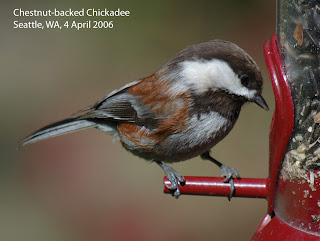Here it is late October, and the Snow Geese (Chen caerulescens) have made their annual transhemispheric trip from Wrangel Island, off the north coast of Siberia, across the Bering Straits and down into North America. Up to 100,000 or more birds are thought to make this journey, without a doubt the largest crowd of emissaries from Russia to the United States. Forty thousand pairs are thought to breed on Wrangel Island, and they bring with them the young produced each year.
Half of these birds remain for the winter in the Fraser River and Skagit River valleys of southwestern British Columbia and northwestern Washington, the other half continuing down to major wintering grounds in southern Oregon and California’s Central Valley. Many of the birds have been banded on Wrangel Island, and they bear conspicuous numbered plastic neck collars.
This migration, of very large numbers of birds moving from restricted nesting grounds to restricted wintering grounds, is typical of geese, which seem to function best in a highly social setting. They are herbivores, grazing on grasses and forbs in open areas, and there is usually more than enough food for all. If you’re a herbivore, the world is your breakfast (lunch, dinner) table! Especially if you can eat just about any kind of herbaceous green plant.
These large groups of geese probably facilitate mating (the young birds are surrounded by potential mates) and predator awareness (how could a potential predator sneak up on such a large number of eyes and ears?). The major predator of the Skagit Valley geese is the Bald Eagle, but predation is infrequent. Eagles probably get mostly sick and infirm birds, the ones that don’t make it into the air when an eagle flies over and flushes an entire flock (which may include thousands of birds).
On the nesting grounds on Wrangel Island, Arctic Foxes take their toll. But the greatest mortality source of our Snow Geese may be from hunting on their winter grounds. Birds wounded but not killed by shot probably fall victim to eagles and possibly other predators such as Coyotes. Nevertheless, hunting is strictly regulated and has negligible effect on the goose populations.
The average clutch of Snow Geese is about four eggs. Of them, 80% reach hatchling stage, and 75% of those reach fledging. Thus each pair of adults should produce on average about two young each year. Without heavy mortality, this would lead to a population increase, and that in fact is what is happening with Snow Geese throughout most of their range, leading to conservation and management problems. The widespread availability of agricultural land in winter and the opportunity to expand to new nesting areas in the Arctic combine to enhance population growth. The Wrangel Island population is an exception, having been stable in recent years.
Many immatures are evident in the Skagit flocks, in their distinctive gray plumage. The immatures attain adultlike plumage by the time they are one year old but do not breed until they are three years of age. The birds are censused annually, and the percentage of immatures in the wintering population is an easy way to measure breeding success in the previous summer. Young birds of this population pair during their third winter, and the pair stays together until one of them dies; life span may be two decades or more.
The Snow Geese of the Skagit Valley provide one of the most spectacular of wildlife spectacles in the state. Throughout each winter, carloads of people stop in designated parking areas and watch flocks, sometimes immense flocks, of the geese feeding and flying at pointblank range. They are surely the envy of groups of hunters waiting in vain in nearby fields with their “flocks” of decoys. The birds move between feeding areas, so there are often birds in the sky coming and going.
To see a V-formation of Snow Geese approach from high in the sky, then drop toward the ground by dumping air from under the wings, some of them even briefly upside-down, furnishes a thrill for all who are watching. At the last moment of their descent, the birds extend their webbed feet and spread their tail, as if putting on the brakes, flap vigorously, and settle to the ground. Heads down, they move slowly forward, biting off grass blades as they go. Grass is planted in wildlife management areas set aside for the geese.
These flocks should be checked for the so-called blue morph, previously thought to be a different species, the “Blue Goose.” This morph is common in the central Canadian breeding populations that winter in central United States but has always been rare in the Pacific Northwest. Apparently a few such birds have found their way into the Wrangel Island population, and we see them every winter. They are easily recognized by their dark body and white head; the immatures are much darker than typical Snow Geese.
Dennis Paulson

1.jpg)















